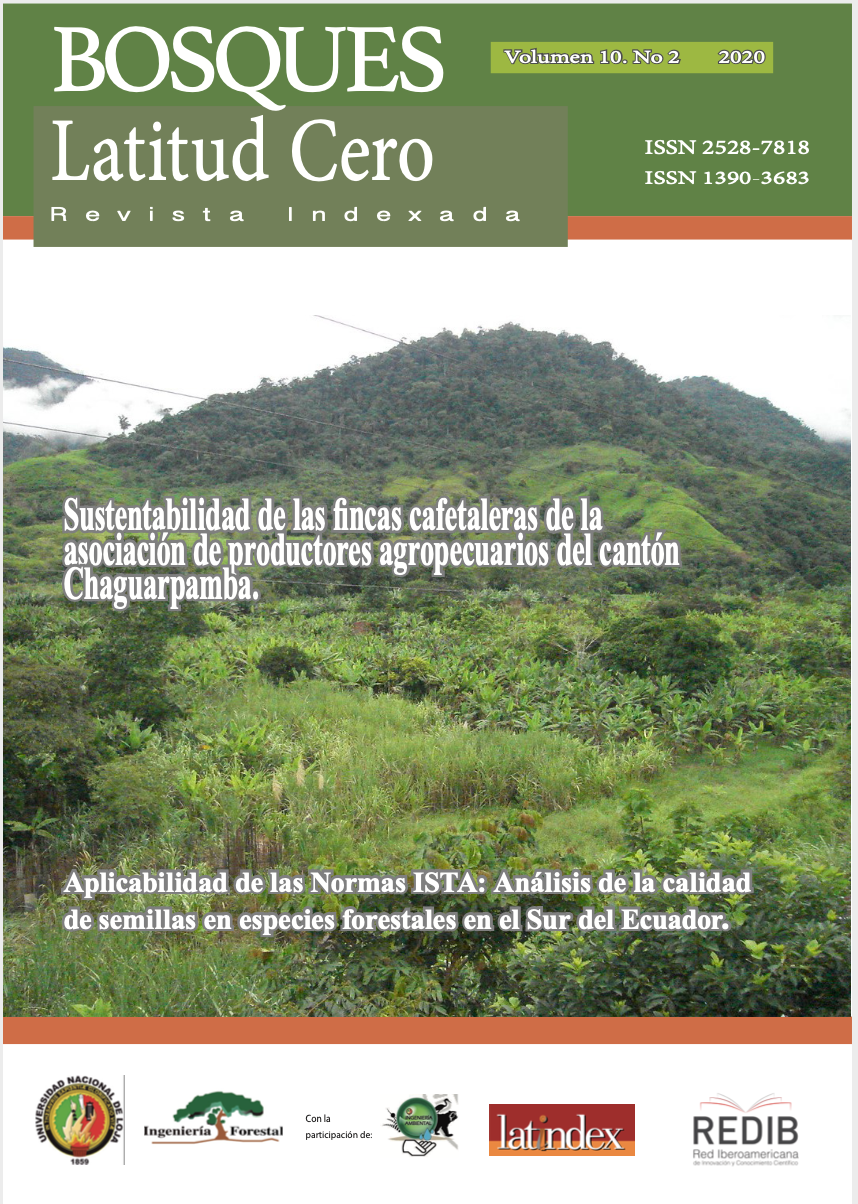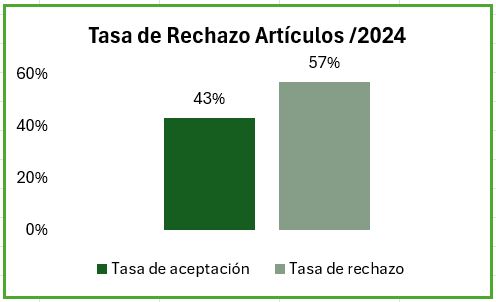Microscopic characteristics of wood in three mangrove species from southern Ecuador
Keywords:
Xylem, mangrove, wood anatomy, Rizophoraceae, IAWAAbstract
Mangroves are forest ecosystems characterized by their tolerance to salinity, and with their roots and stems act as strong structures for the protection of coastal areas. The accelerated expansion of shrimp ponds and the agricultural frontier in Ecuador are its main threat. Its wood is used for construction and as charcoal, however, little has been studied its anatomical properties at the microscopic level. Therefore, based on the IAWA regulations, the anatomical characteristics of three mangrove species are described: Avicennia germinans, Rhizophora mangle, and Laguncularia racemosa from the Santa Rosa canton, El Oro province in southern Ecuador. Qualitatively, only A. germinans and L. racemosa presented porous growth rings with remains of phloem strands and fine uniseriate and interspersed bands of sclereid cells. A. germinans and R. mangle presented sparse paratracheal axial parenchyma and L. racemosa diamond-shaped axial parenchyma. In A. germinans and L. racemosa, simple perforation plates with alternating pits were observed, and in R. mangle, scallop plates and pits were observed. All three species had radii of different sizes and thick to very thick-walled fibers. Quantitatively, all species had a mean vessel length ≤ 350-800 μm and up to 100 vessels per square millimeter. There was a high variability in the anatomical structure in the three species. The remains of phloem strands and thin uniseriate and interspersed bands of sclereid cells allow A. germinans and L. racemosa high flexibility against winds and tides.References
Acosta, M. (1961). Los Manglares del Ecuador. Revista Geográfica, T. 28, 54, 69–88.
Bravo, M. (2010). Interpretación del estudio multitemporal ( CLIRSEN 1969-2006 ) de las coberturas de manglar , camaroneras y salinas en la franja costera del Ecuador Continental. Universidad de Guayaquil.
Carlquist, S., y Hoekman, D. A. (1985). Ecological wood anatomy of the woody Southern Californian flora. IAWA Journal, 6(4), 319–348.
CLIRSEN,(Centro de Levantamientos Integrados de Recursos Naturales por Sensores Remotos). (1990). Estudio Multitemporal de los Manglares, Camaroneras y Areas Salinas de la Costa Ecuatoriana. (Centro de Levantamientos Integrados de Recursos por Sensores Remotos, Ed.). Quito, Ecuador.
Detienne, P. y P. Jacquet. 1983. Atlas identificando los bosques del Amazonas y las regiones vecinas. Centro Técnica Forestier Tropical, Nogent s/Marne. 640 pp
Detienne, P., y Jacquet, P. (1984). Atlas d’identification des bois de l’amazonie et des region voiseines. (Técnica del centro Forestier Tropical, Ed.) (Vol. 5). Nogent s / Marne.
Feijoo, C. E., Ramón, D. D., y Cofrep-Pucha, D. (2018). Guía para cortes anatómicos de la madera. (A. y de R. N. R. Facultad, de I. Carrera, y de A. de M. T. Laboratorio, Eds.). Loja.
Iñiguez-Gallardo, V., y Jurrius, I. (2019). Vulnerabilidades y adaptación al cambio climático de usuarios de manglar: caso de análisis de manglares del sur del Ecuador. En Universidad Espiritu Santo (Ed.), Primer Congreso Manglares de América (pp. 161–176). Samborondón-Ecuado
Jurrius, I., y López, F. (2020). Monitoreo Comunitario y Participativo de los Manglares bajo Acuerdos de Uso y Custodia de Manglar en Ecuador. Investigatio, 14, 27–37. https://doi.org/10.31095/investigatio.2020.14.3
Krauss, K. W., y Goldstein, G. (2016). Tree Physiology Tropical Tree Physiology Adaptations and Responses in a. (G. Goldstein y L. S. Santiago, Eds.). Springer Berlín Heidelberg. https://doi.org/10.1007/978-3-319-27422-5
Leon, W. (2014). Anatomía del Leño , Aspectos Ecológicos y Filogenia en Mangles de Venezuela. Forest, 45(2)(Diciembre), 191–203.
MAE (Ministerio del Ambiente del Ecuador)., y FAO (Organización de las Naciones Unidas para la Alimentación y la Agricultura). (2014). Árboles y arbustos de los manglares del Ecuador. Quito, Ecuador.
MAE, (Ministerio del Ambiente del Ecuador). (2013). Sistema de Clasificación de Ecosistemas del Ecuador Continental. (Subsecretaría de Patrimonio Natural, Ed.). Quito-Ecuador.
Morales, A., y Herrera, A. (1994). Estudio tecnológico de la madera en tres especies de mangle.
Pesante, J., y Rosero, P. (2019). Recuperación asistida de Rhizophora mangle, Avicennia germinans y Laguncularia Racemosa en cumplimiento a decreto ejecutivo 1391 durante el período 2009-2019 en los estuarios de Ecuador. Anglares de América, 235–243.
Polanía, J., y Lacerda, L. D. (1992). Conservación y aprovechamiento sostenible de bosques de manglar en las regiones América Latina y Africa; informe técnico del proyecto. Parte: América Latina. Talleres sobre Conservación y Aprovechamiento Sostenible de los Bosques de Manglar en las Regiones América Latina y Africa, Niteroi, BR, 28-30 May 1992, 1992-05-28.
Rodríguez, G. de la C., Aguirre, G. A., y Chiriboga, F. G. (2016). La gestión ambiental empresarial, su función frente a los cambios climáticos globales. Camaroneras, caso: manglares de Ecuador. Universidad y Sociedad, 8(3), 43–50. Retrieved from http://rus.ucf.edu.cu/%0ARESUMEN
Spalding, M., Kainuma, M., y Collins, L. (2010). World atlas of mangroves. (Earthscan, Ed.). London.
Studholme, W. P., y Philipson, W. R. (1966). A comparison of the cambium in two woods with included phloem: Heimerliodendron brunonianum and A vicennia resinifera. New Zeal. J. Bot. 4;355-365
Tapia, F. (2020). Costos de Conservación del Manglar : Casos Las Huacas y Pongalillo , en la Provincia de El Oro , al Sur de Ecuador. INVESTIGATIO, (13), 65–76.
Van Vliet, G. (1979). Wood anatomy of the Combretaceae. BLUMEA, 25, 141–223.
Wheeler, E. A., Baas, P., y Gasson, P. E. (2016). IAWA List of Microscopic Bark Features. IAWA Journal, 37(4), 517–615. https://doi.org/10.1163/22941932-20160151
Wheeler, E., Baas, P., y Rodgers, S. (2007). Variations In Dieot Wood Anatomy : A Global Analysis Based on the Insidewood Database. IAWA Journal, 28(3), 229–258. https://doi.org/10.1163/22941932-90001638
Worbes, M. (1989). Growth rings, increment and age of trees in inundation forests, savannas and a mountain forest in the neotropics. IAWA Journal, 10(2), 109–122.
Worbes, M. (1999). Annual growth rings, rainfall-dependent growth and long-term growth patterns of tropical trees from the Caparo Forest Reserve in Venezuela. Ecology, 87, 391–403.
Zamski, E. (1979). The Mode of Secondary Growth and the Three-Dimensional Structure of the Phloem in Avicennia. Botanical Gazette, 140(1), 67–76.
Downloads
Published
Versions
- 2021-02-24 (2)
- 2020-12-31 (1)
How to Cite
Issue
Section
License
Copyright (c) 2020 Bosques Latitud Cero

This work is licensed under a Creative Commons Attribution-NonCommercial-ShareAlike 4.0 International License.
This work is published under the Creative Commons Attribution-NonCommercial-ShareAlike 4.0 International (CC BY-NC-SA 4.0) license. This means that users may copy, distribute, and adapt the content, provided that proper credit is given to the authors and the journal. Commercial use of the material is not permitted. Additionally, any derivative work must be distributed under the same license. This license ensures open access to knowledge, promoting the dissemination and reuse of published works for non-commercial purposes, respecting authorship, and ensuring the free circulation of content under fair terms.





























